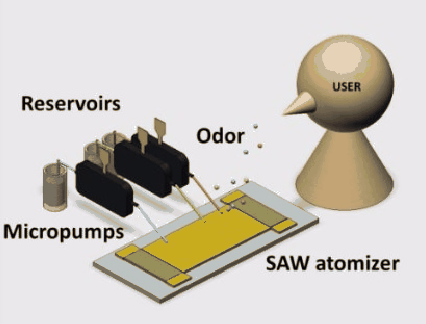
Next: Taste physiology and perception Up: 13.2 Smell and Taste Previous: Smell physiology and perception Contents Index
Adding scent to films can be traced back to the early 20th century. One system, from 1960, was called Smell-O-Vision and injected 30 different odors into the movie theater seats at different points during the film. The Sensorama system mentioned in Figure 1.29(c) of Section 1.3 also included smells. In addition, the military has used smells as part of simulators for many decades.
A survey of previous olfactory displays and interfaces appears in [137], along with current challenges and issues. Olfactory displays have been shown to induce strong cognitive and emotional responses from people, which makes them attractive for increasing immersion in VR [139].
It also offers advantages in some forms of medical treatments that involve cravings and emotional responses. Surprisingly, there is even recent evidence that pleasant odors help reduce visually induced motion sickness [149].
 |
Olfactory displays usually involve air pumps that can spray chemical compounds into air. The presentation of such engineered odors could be delivered close to the nose for a personal experience. In this case, the canisters and distribution system could be worn on the body [363]. A recent system is depicted in Figure 13.5. Alternatively, the smells could be delivered on the scale of a room. This would be preferable for a CAVE setting, but it is generally hard to control the intensity and uniformity of the odor, especially in light of air flow that occurs from open windows and air vents. It might also be desirable to vary the concentration of odors over a large area so that localization can be performed, but this is again difficult to achieve with accuracy.
Steven M LaValle 2020-01-06